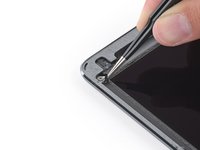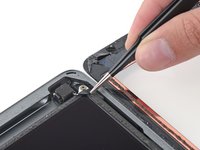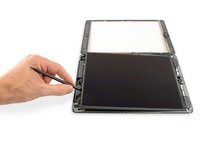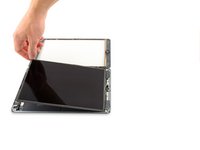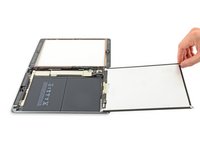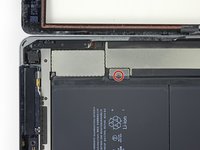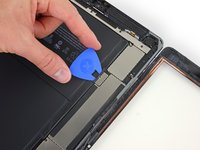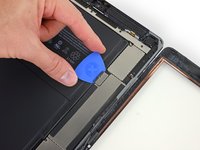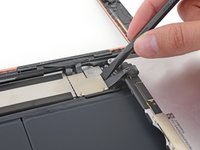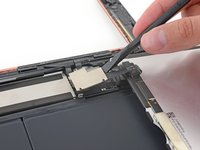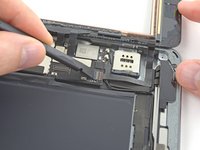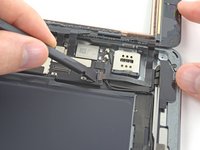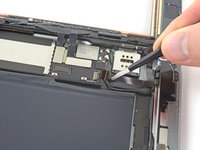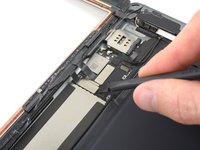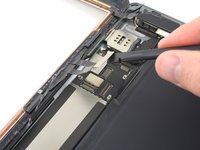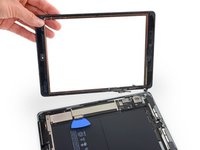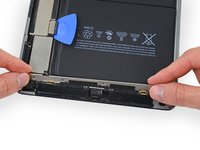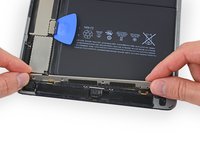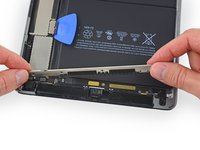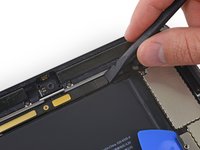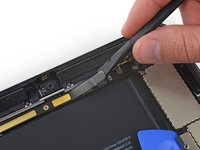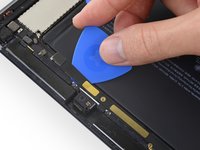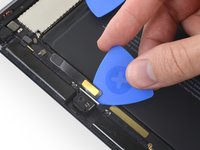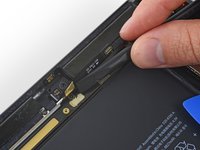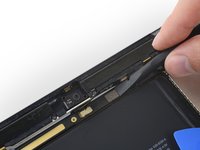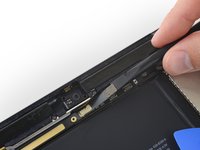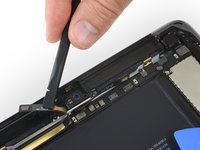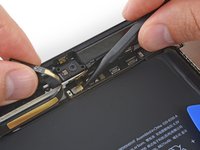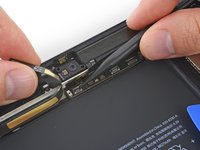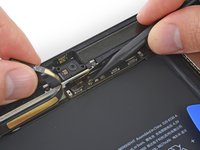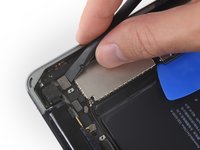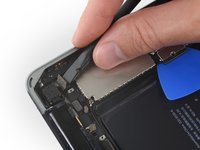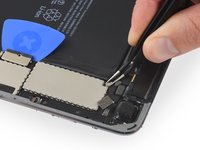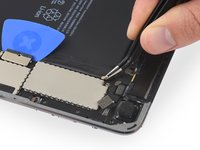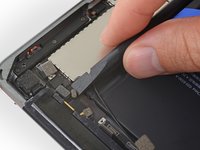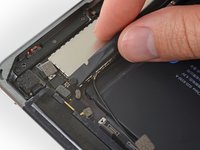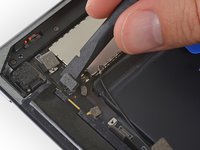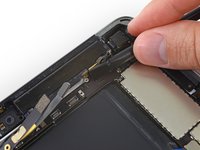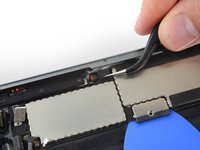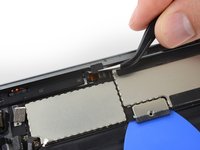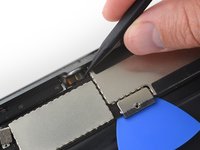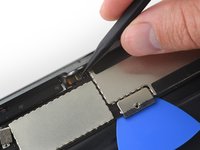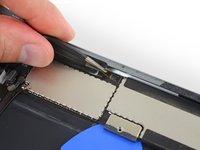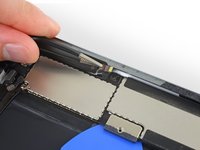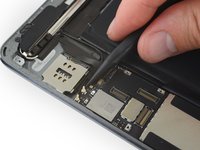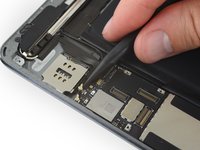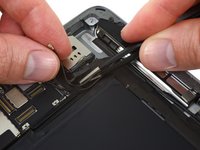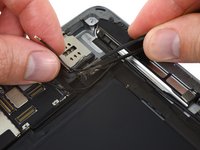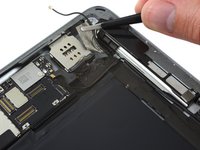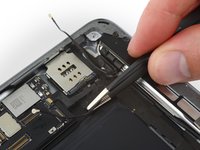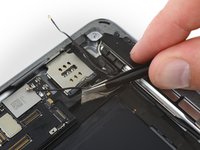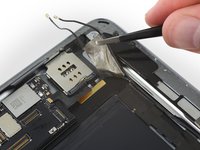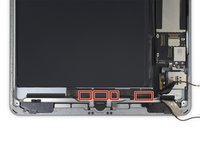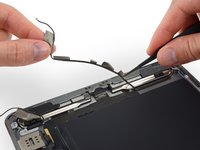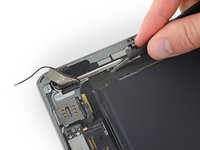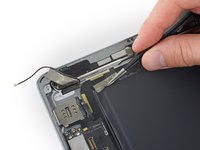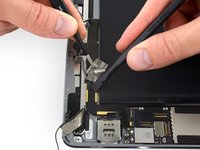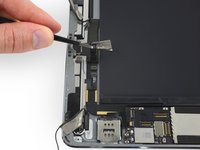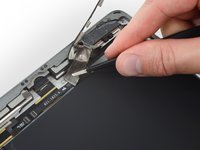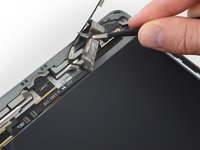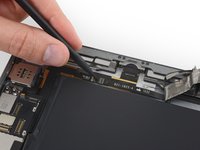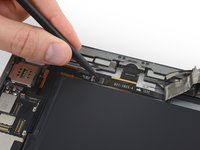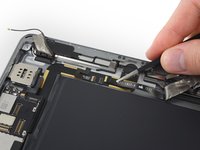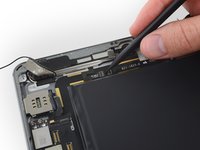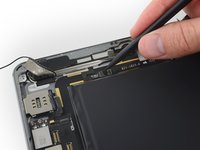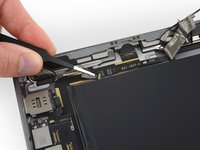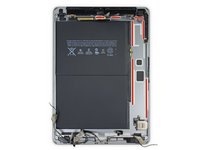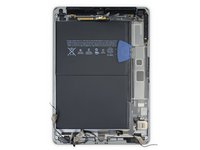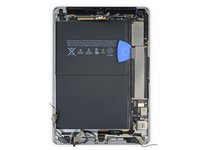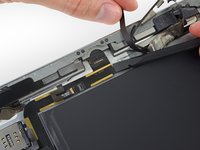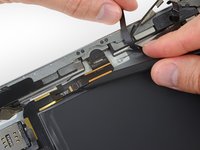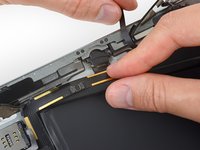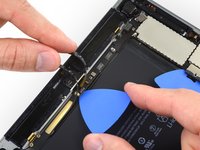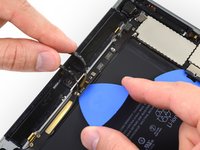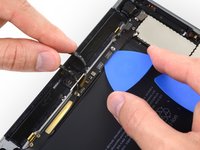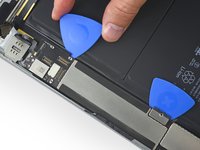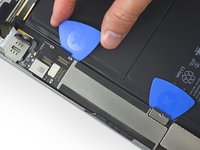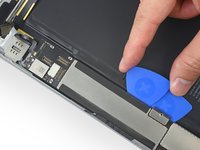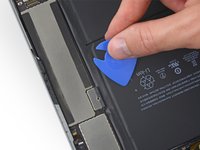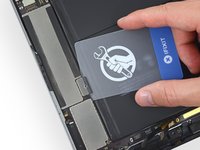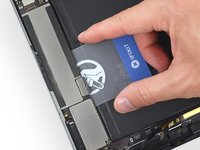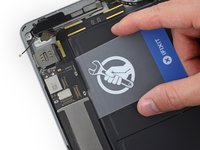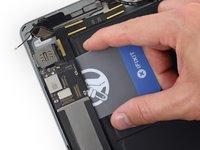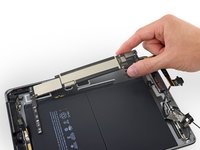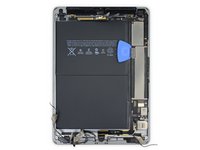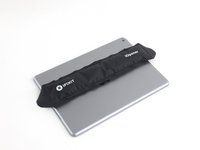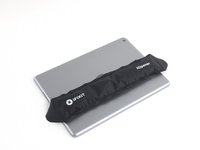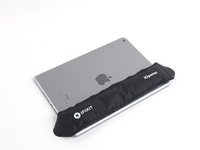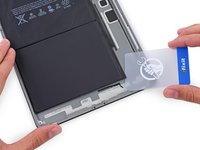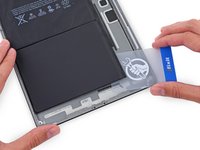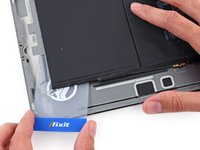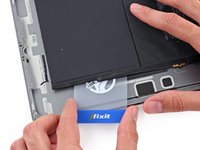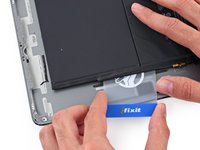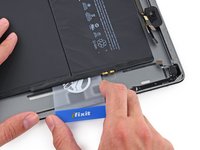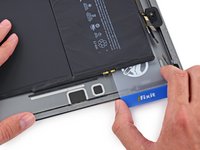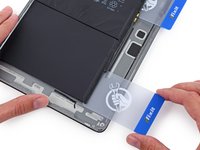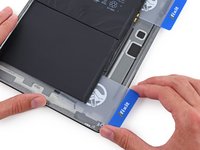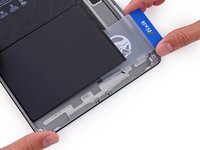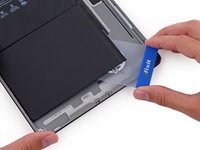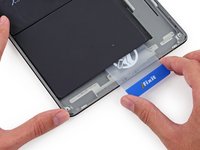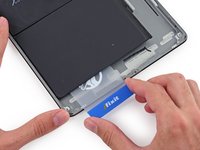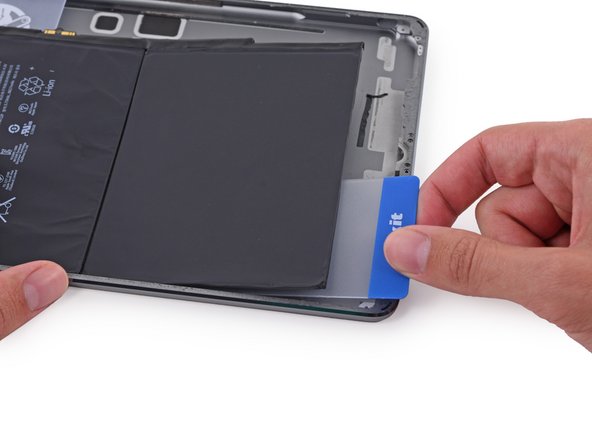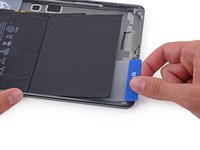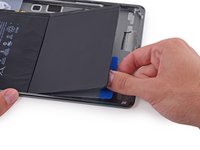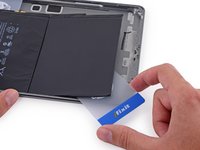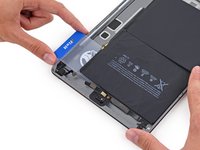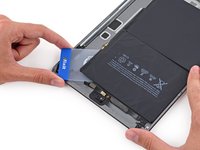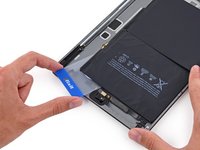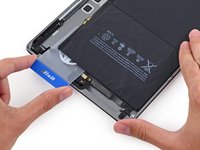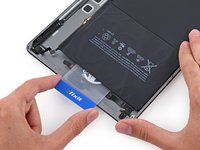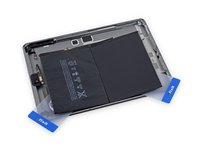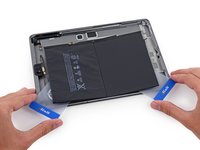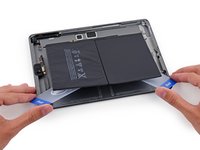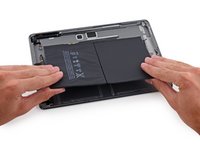Introduzione
Segui questa guida per sostituire la batteria nel tuo iPad 5 LTE.
Prima di cominciare, scarica la batteria del tuo iPad sotto al 25%. Questo ridurrà al minimo il rischio di un pericoloso evento termico se la batteria viene accidentalmente forata o danneggiata.
Le batterie agli ioni di litio contengono sostanze chimiche pericolose e potrebbero prendere fuoco ed esplodere se forate o maneggiate male. Presta attenzione.
Alcune foto di questa guida sono di un modello Wi-Fi e i componenti interni potrebbero apparire leggermente diversi dal modello LTE. La procedura è la stessa per entrambi, tranne dove specificato.
Attenzione: il metodo di isolamento della batteria in questa guida è obsoleto e potrebbe risultare in danni irreversibili ai pin della batteria sulla scheda logica, distruggendola. Se scegli di isolare la batteria in questo modo, presta attenzione a tutti gli avvertimenti e lavora con estrema cautela. Se scegli di completare la guida senza isolare la batteria, evita di usare strumenti di metallo tranne quando strettamente necessario (ad esempio quando rimuovi le viti) per evitare di causare un corto circuito della batteria e danneggiare componenti sensibili del circuito.
Cosa ti serve
-
-
Scalda un iOpener e appoggialo al bordo sinistro del dispositivo per due minuti.
-
-
-
Mentre aspetti che l'adesivo si allenta, prendi nota delle seguenti aree che sono sensibili alla leva:
-
Fotocamera frontale
-
Antenne
-
Cavi dello schermo
-
-
Attrezzo utilizzato in questo passaggio:Clampy - Anti-Clamp$24.95
-
Tira indietro la manopola blu per sbloccare i bracci dell'Anti-Clamp.
-
Posiziona un oggetto sotto il tuo iPad così che rimanda parallelo alla superficie di appoggio tra le due ventose.
-
Posiziona le ventose vicino al centro del bordo sinistro, una sulla parte superiore e una sulla parte inferiore.
-
Tieni ferma la parte inferiore dell'Anti-Clamp e premi con decisione sulla ventosa superiore per farle fare presa.
-
-
-
Aspetta un minuto per dare all'adesivo la possibilità di separarsi e creare una fessura per l'apertura.
-
Se lo schermo non si sta scaldando abbastanza, puoi usare un asciugacapelli per scaldare lungo il bordo sinistro dell'iPad.
-
Inserisci un plettro di apertura sotto il digitizer quando l'Anti-Clamp crea una fessura abbastanza grande.
-
Salta il prossimo passo.
-
-
-
Una volta è caldo al tatto, appoggia una ventosa con manico al bordo sinistro dello schermo, il più vicino possibile al bordo.
-
Solleva lo schermo con la ventosa per creare una piccola fessura tra il digitizer e il telaio.
-
Inserisci un plettro nella fessura tra il digitizer e il telaio.
I had a screen that was lightly cracked, and when I pulled up on the glass it cracked even further and made a mess of my removal. So, I would recommend taping cracks even if you can get suction so that you don’t induce even more cracks.
I actually had a really badly cracked digitizer. Using the suction cup did nothing but shatter the digitizer more. I intentionally drove a flat head screw driver into the digitizer to reveal the recess in the body where they are showing the opening-pick. Working around the edge, the glass shattered. You still need to be careful at all of spots noted in step 2.
Do not go under the digitizer more than the 1 mm along the sides or 3-4 mm at the corners as shown in step 29 using the flat grey ring around the edge for a reference. Direct all of your tool force into the body to prevent slipping into critical parts.
The antennas at either side of the home button were the trickiest part as they were thin and slightly attached to the digitizer. I would recommend using a plastic tool for these parts if you are having to 'scrape' the glass off of the tabs of the antenna.
-
-
-
Inserisci un secondo plettro nella fessura che hai appena creato.
-
Fai scorrere il plettro verso l'angolo in basso a sinistra del dispositivo per separare l'adesivo.
-
Lascia il plettro nell'angolo in basso a sinistra per evitare che l'adesivo si rincolli.
-
-
-
Scalda un iOpener e appoggialo sul bordo superiore del dispositivo per due minuti.
-
-
-
Fai passare il plettro intorno all'angolo in alto a destra del dispositivo per separare l'adesivo.
-
-
-
Fai scorrere il plettro di apertura lungo il bordo superiore del dispositivo, fermandoti appena prima di raggiungere la fotocamera frontale.
-
-
-
Scalda un iOpener e appoggialo sul bordo destro del dispositivo per due minuti.
-
-
-
Gira intorno all'angolo in alto a destra del dispositivo con il plettro per separare l'adesivo.
-
-
-
Inserisci un nuovo plettro di apertura e fallo scorrere verso il centro del bordo destro dell'iPad.
There are sensitive display/digitizer cables no less than five inches from the bottom edge of the iPad. Insert the pick further down than this, or deeper than 1mm beyond this point and you risk irreparably damaging these cables.
Three inches is much too far down this side of the iPad to use picks.
-
-
-
Scalda un iOpener e appoggialo al bordo inferiore del dispositivo per due minuti.
-
-
-
Fai scorrere il plettro in basso a sinistra verso l'angolo in basso a sinistra per separare l'adesivo.
-
Lascia il plettro inserito nell'angolo in basso a sinistra prima di passare al prossimo passo.
-
-
-
Inserisci un nuovo plettro nella fessura che hai appena creato sul bordo inferiore dell'iPad.
-
Fai scorrere il plettro oltre l'antenna, fermandoti appena prima del tasto home.
-
Lascia il plettro a sinistra del tasto home prima di continuare.
-
-
-
Scalda un iOpener e appoggialo al bordo destro del dispositivo per due minuti.
-
-
-
Mentre supporti il digitizer, fai scorrere un plettro di apertura tra i due cavi dello schermo per separare l'adesivo rimasto.
-
-
-
Una volta che tutto l'adesivo è separato, apri il digitizer come un libro e appoggialo parallelo all'iPad.
While reassembling, REALLY make sure the display cables and the home button cable won't be folded / bent while closing the digitizer. I'm not exactly sure what I did, but I broke the home button and touch ID since I bent the home button cable to the point that it broke. These ribbon cables are SUPER fragile.
-
-
-
Usa la parte piatta di uno spudger per sollevare LCD dal suo alloggiamento quanto basta per poterlo afferrare con le dita.
-
Apri l'LCD dell'iPad come la pagina di un libro, sollevandolo vicino alla fotocamera e ruotandolo oltre l'estremità del tasto home.
-
Appoggia l'LCD sulla sua parte anteriore per aver accesso ai cavi dello schermo.
Pictures that better indicate the difference between the remaining adhesive and the two mylar cables (the very cables you are trying to avoid damaging!) would be much appreciated. On my unit the two were very hard to distinguish
-
-
-
-
Rimuovi l'unica vite a croce Phillips da 2,3 mm che fissa il connettore della batteria alla scheda logica.
-
Lascia il blocco in posizione per evitare che i cavi del connettore della batteria facciano contatto finché non hai completato la riparazione.
The could recommend me since I did not put the wedge first in the connection of the battery and it heated the logic card a couple of minutes, q´l recommend to solve it since it does not turn on
The battery isolation pick didn’t come with my kit. I made my own using one of the regular picks and a pair of scissors.
Would it not be important to note that you are not really “disconnecting” the conduit of the battery from the logic board, but rather isolating the connection?
@dlcatftwin I’m not sure I understand the distinction you’re making. You are fully disconnecting the battery, by opening the circuit and wedging a big insulator in there to keep it from closing again accidentally.
Hello Jeff,
Thank you for responding. one may regard “disconnecting” as actually unplugging or unsocketing a cable connection as actually disconnecting, like in step 37. I could picture a person tugging on the pick thinking that the battery connector actually had to be lifted away from the board.
Probably over-thinking it! ;-)
Regards,
DLC
@dlcatftwin 100% on point. That’s exactly why I’m reading this comment right now. I’ve never heard of a “Battery Isolation Pick” and I was trying to get the connector loose, before realizing it wasn’t coming easy and therefore reading the comments for more info.
Ergo, there is some confusion here that should be noted in the primary instructions.
-
-
-
Rimuovi le tre viti a croce Phillips da 1,4 mm che tengono ferma la staffa del cavo del display.
-
-
-
Usa la parte piatta di uno spudger per sollevare delicatamente la staffa del cavo del display direttamente dalla scheda logica.
My iPad Air2 is configured differently from that in these photos. The battery connector is next to the display cable connection, and the LCD/glass panel are integral, so that they lift out of the frame together.
-
-
-
Rimuovi tutto il nastro adesivo che copre il connettore del cavo a nastro del tasto home.
-
-
-
Usa la parte piatta di uno spudger per aprire l'aletta sul connettore ZIF del cavo a nastro del tasto home.
-
Sfila il cavo a nastro del tasto home con attenzione dal connettore ZIF.
On reassembly take note of the flap lock on that connection. Sadly I failed to operate it correctly and now have a defunct home button.
-
-
-
Usa la parte piatta di uno spudger o un'unghia per rimuovere i due connettori del cavo del digitizer direttamente dalle loro prese.
When reversing with the new screen , this was the hardest part for me.
The cables needs to fit under the LCD screen, and they kept going out of place when I tried to close the screen in the end.
That meant that I had to remove the LCD again with one hand while holding the digitizer/glass with the other - all while I had already exposed the adhesives.
for me the cables of the new screen were longer that the old one. So even if i put everithing under the lcd, the digitizer didnt close properly. After everything was put back togheter, this side of the digitizer keep popping out.
I do have the same problem.
Anne -
In step 41 - what is the name of the connector in the first picture which he is trying to open
It is a ZIF socket. (Zero insertion force)
Zach -
-
-
Attrezzo utilizzato in questo passaggio:Polyimide Tape$9.99
-
Rimuovi l'assemblaggio del pannello frontale.
-
Se si verificano problemi di tocchi "fantasma" con lo schermo nuovo, si possono risolvere aggiungendo uno strato di nastro isolante molto sottile, come il nastro Kapton (polyimide), alle aree evidenziate sul retro del pannello. I pannelli iFixit sono già isolati correttamente e non dovrebbero richiede l'aggiunta di nastro adesivo.
After removing the glass, I'd suggest scraping off any remaining black adhesive off of the iPad's frame. Get every speck. This may be time consuming if you have lost glass integrity and have sticky, splintered shards around the edge of the frame, but you need the frame completely clean of adhesive before you put the new front panel down or else it won't lay correctly in the frame.
This was not as hard as I expected it. I think I was lucky since the adhesive wasn’t properly working anymore, and my display wasn’t too shattered. Took me a about 40 minutes to remove the display. Unfortunately I noticed that my battery had expanded so ordered a new one, waiting for it to arrive before I put it all back together.
-
-
-
Usa delle pinzette e rimuovi il pezzo di nastro adesivo che copre il connettore del cavo della scheda della SIM sulla scheda logica.
-
-
-
Rimuovi le seguenti viti che tengono ferma la staffa del cavo del componente superiore:
-
Due viti a croce Phillips da 2,0 mm
-
Tre viti a croce Phillips da 1,4 mm
-
-
-
Usa la parte piatta di uno spudger per scollegare il connettore della fotocamera interna dalla sua presa sulla scheda logica.
-
-
-
Usa la parte piatta di uno spudger per scollegare delicatamente il cavo a nastro del jack cuffie dalla sua presa sulla scheda logica.
-
Di nuovo, spingi di lato questo secondo cavo a nastro per scoprire altri connettori al di sotto.
There is tape on the LTE model adhering this socket to the frame underneath.
-
-
-
Usa la parte piatta di uno spudger per scollegare il cavo di interconnessione dell'antenna cellulare primaria dalla sua presa sulla scheda logica.
I accidentally broke the 's' interconnector. where can I buy the replace? Or can i use something similar ? F.e. old antenna in other iphone ? Thank you !
-
-
-
Usa la parte piatta di uno spudger per piegare verso l'alto e spostare con cautela la staffa del cavo di interconnessione dell'antenna cellulare primaria.
I accidentally broke the 's' interconnector. where can I buy the replace? Or can i use something similar ? F.e. old antenna in other iphone ? Thank you !
-
-
-
Ripeti il passo precedente per rimuovere un secondo pezzo di nastro adesivo direttamente al di sotto, che fissa il cavo dell'antenna Wi-Fi di sinistra.
-
Se hai sollevato per sbaglio entrambi i pezzi di nastro adesivo insieme, separali con cautela prima di procedere al passo successivo.
-
-
Attrezzo utilizzato in questo passaggio:Plastic Cards$2.99
-
Rimuovi il plettro di isolamento della batteria.
-
Inserisci una scheda di plastica sotto la scheda logica, in corrispondenza del connettore della batteria.
-
Fai scorrere la scheda completamente sotto la scheda logica, separando l'adesivo lungo il bordo esterno.
-
-
-
Tira il connettore Lightning dal suo alloggiamento nel case posteriore.
Remove the two screws from the inside of the connector first!
Hi George, thanks for pointing that out. I believe the screws you’re talking about are removed in step 70, is that correct? Let us know if we missed some screws!
-
-
-
Riscalda l'iOpener nel microonde per 30 secondi.
-
Posiziona l'iOpener riscaldato dietro l'iPad al centro. Lascialo per 90 secondi per ammorbidire l'adesivo della batteria.
-
Muovi l'iOpener verso destra (lontano dalla fotocamera posteriore), e lascialo lì per 90 secondi.
-
Infine, muovi l'iOpener verso il bordo destro dell'iPad e lascialo in posizione per 90 secondi.
-
-
Attrezzo utilizzato in questo passaggio:Plastic Cards$2.99
-
Inserisci una scheda di plastica sotto la cella inferiore della batteria, nell'angolo in basso a destra.
Did you skip Step 46 through 100, then this is for you: Because the logic board is still in, you will have less space to loosen the battery pack. Be extra careful not to bend it. Work from the sides that are more accessible like in Step 113 and slowly work your way underneath the battery pack to loosen it all over. As I was loosening the battery I had the heated iOpener underneath the part I was working on. This really helped a lot. And be patient. You do not want to force it.
First of all, thanks @marcelflueeler and everyone else who gave advice on skipping ahead. This is definitely the way to go if you're just changing a battery! Once you've unstuck the battery you'll find you can't pull it out because it's stuck at the terminal though. Don't try and force it here! You'll need to return to step 88 and soften the logic board adhesive so you can pry it up about a cm, then you can lift the battery terminal up and over the locking post that's holding it in place. I didn't realise this and broke a piece of plastic off the old battery terminal, which got lodged under the logic board and prevented a good battery contact until I realised and retrieved it.
-
-
-
Afferra saldamente entrambe le schede e ruotale per sollevare la batteria dal case posteriore.
-
Rimuovi la batteria dal case posteriore.
Finally done !
It took me nearly 3hrs, but i finally made it. Thanks for the great instructions
REASSEMBLY TIPS:
The adhesive strips that come with the iFixit battery have no labels to say which goes where. Look at them carefully and one side has a blue protective cover that runs the length of each strip. This faces up and is to be removed at the last moment when you’re ready to stick the screen down permanently. One strip has a narrowed section in the long length to clear the glass touch screen cables, so stick this one down first to avoid mistakes.
Before removing the protective strips, close the touch screen and boot the iPad. Test both cameras, wifi and speakers. (I found the rear facing camera connector hadn’t bedded properly which was easily fixed). Clean the screen and remove dust from LCD before bedding in touch screen.
The iFixit site has updated battery calibration instructions which differ from the card packed with the battery:
Charge it to 100% and keep charging it for at least 2 more hours.
Then use your device until it shuts off due to low battery.
Finally, charge it uninterrupted to 100%.
Great tip to boot the iPad before removing the adhesive from the battery. There are quite a few comments here about faulty batteries. Fortunately, mine worked just fine.
The iFixit battery replacement kit worked great! The repair guide is very good also. So glad I didn’t just try buying the battery. While testing everything after finishing the battery replacement, the digitizer, volume controls and the sleep button did not work. I was very happy when I went back in and found the cable connections had just come loose. My wife couldn’t believe I fixed her iPad.
The guide was pretty good but a few comments:
I didn’t liked the iOpener that much. I used an heat gun with good temperature control instead.
Any advice on how to remove the old glue residu would have been welcome. I used a combination of physical scraping and cleaning afterward with isopropyl alcohol.
An extra guide on how to apply the new adhesive strips would also be nice.
Fixed!....The guide is very clear and well laid out. I also had issues with the iOpener not working, I needed more heat, used heat gun with temp control. Also used floss to remove the logic board. Would have appreciated more clearer instructions on adding the adhesive strips.....Thanks
The iOpener is really bad. It isnt hot enough to keep the iPad that cools down to roomtemperature in a few seconds. I used an hair dryer which was also not warm enough but at least made it warm enough to create a gap where I was able to fit my pics under. Unfortunately my Digitizer still died. Battery works but I cannot turn off my iPad now lol
Very good guide to a very tedious project! Thank you for the detailed description of the digitizer separation. I didn’t sever any cables. The iOpener isn’t bad; it’s just too small. This project really requires the Anti-clamp, the acetone/isopropanol adhesive softener, and a heat gun that can be used at a low heat setting. I didn’t try a hair dryer, but I think that it might be too windy. Like other fixers,I skipped steps 47 thru 100 something and took my chances manhandling the battery. I opted to insulate the digitizer with Kapton tape. I only have a wide roll of Kapton, so I stuck it to the stiff plastic backing for the battery, then cut narrow strips and peeled them off the backing. Finally, I’d like to see a show of hands of the people who forgot to put in the four corner screws for the display. Maybe I’m the only one …
I successfully replaced the battery in my A1954. But I stopped at step 40 and then I just pried the old battery with the plastic cards that came with the new battery and some isopropyl alcohol. Next step I pried the logic board upwards with a blue pick around the screw area. The board needs to flex upwards more than you're comfortable with in order to make room for the new battery connector to slide underneath the pick but over the screw hole underneath the logic board. I dint't really feel like gutting the entire housing of all the parts but I was risking damaging both the logic board and the new battery. So do it at your own risk.
-
Per rimontare il dispositivo, segui queste istruzioni in ordine inverso.
Per rimontare il dispositivo, segui queste istruzioni in ordine inverso.
Annulla: non ho completato questa guida.
Altre 11 persone hanno completato questa guida.
Un ringraziamento speciale a questi traduttori:
100%
Sara Balestra ci sta aiutando ad aggiustare il mondo! Vuoi partecipare?
Inizia a tradurre ›
2Commenti sulla guida
The battery replacement went off without a hitch, I’ll be honest, at step 50 I started to look at things with a real tech eye. I stopped disconnecting and removing components and took my hairdryer to the back, the battery came up quite easily so I stopped, popped in the new battery right then. After reconnecting everything, using iso to clean the lcd and inside glass, I “dry fit” everything back together, powered it up… nice. Completed new adhesive install and all is good.
Great tutorial, but if you have a good tech background, you can knock off an hour and do it in just over an hour. PS - Hair dryer is a must - take your time on this, once you get past the initial opening of the left side, the rest is a breeze.





































































































































